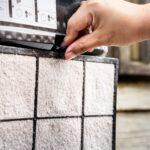With air conditioning season upon us, we see many A/C issues and answer many A/C questions related to filters. While they’re mostly unseen (and pretty unexciting, we admit), filters have a big impact on your day-to-day comfort and on your wallet. Yet they’re often misunderstood. So today we’re providing some furnace filter guidance that you can use to stay cool all summer and get the most out of your HVAC system all year.
Here’s what we’ll cover in this post:
- The difference between a “furnace filter” and an “A/C filter”
- The location of your filter
- The difference between a “furnace filter” and an “air filter”
- The various types of filters
- The significance of MERV ratings
- Replacing a lower-efficiency filter with a higher-efficiency one
- The type of filter you should choose
- How often to change your filter
- Recognizing the signs that your filter needs changing
It’s a lot, homeowners, but we want to answer all common filter questions we get and be a useful resource for you. Let’s get started!
What’s the difference between a furnace filter and an A/C filter?
There’s usually no difference between a furnace filter and an A/C filter. They’re the same filter. Central air systems share the same air handler and air intake vents, so a single filter serves both your furnace and your air conditioner.
You just tend to hear the term “furnace filter” in colder months, and “A/C filter” in the warmer months. But these terms usually refer to the same thing.
Now, there are some homes that do have separate filters for their air conditioners. This can be the case for some homes in warmer climates, and for some older homes without an integrated heating and cooling system. In these cases there may be large, wall-mounted return air vents throughout the house. In a slot just behind their covers, these air vents hold filters for cool air. These filters are A/C filters.
But again, usually a “furnace filter” and an “air conditioning filter” are the same thing: a single filter that traps airborne dirt and debris in both warm and cool air.
Where is my furnace filter?
You can find your furnace filter – perhaps unsurprisingly – at your furnace. Typically it is located at the entrance to the blower compartment. For residential central heating systems where air flows upward, the blower tends to be the lower part of the furnace. For systems where air flows downward, the blower tends to be the upper part of the furnace.
The blower compartment has a door that you can slide or pop off to reach the filter.
This is why we like to refer to the filter for your HVAC system as your “furnace filter” – to indicate where the filter is.
Now, if you have return air vents installed in your walls, you will also find additional filters located behind the vent covers. These are the A/C filters that we discussed earlier.
What’s the difference between a furnace filter and an air filter?
A furnace filter and an air filter are two totally separate products.
A furnace filter, as described above, is a device typically found at the entrance to your furnace’s blower compartment. It traps particles in both warm and cool air. Every forced-air furnace has a filter. It is a critical accessory.
An “air filter” is a shorthand term that refers to an indoor air quality system. This is not a furnace accessory. It’s a different HVAC product.
An indoor air quality system purifies your air to a degree that a typical furnace filter cannot deliver. We discussed air purification systems in a recent blog post – check it out if you’d like to improve the air quality in your own home.
Many people – sometimes even HVAC professionals – say “air filter” when referring to a furnace filter. It’s not exactly wrong – filters treat the air, after all – but it is confusing. A good HVAC company will take the time to understand your filter questions and answer them correctly. They’ll also make sure you know what they mean any time they use the word “filter.”
What are the different types of furnace filters?
Furnace filters come in a range of sizes, materials, and effectiveness levels. The type of filter you should use depends on your HVAC system and your air quality preferences.
Here are the most common types of furnace filters:
Fiberglass filters
Fiberglass filters are the least expensive and most readily available type of filter. You can find them in hardware stores, big box stores, and even grocery stores.
Fiberglass filters are mesh filters made of spun glass. They are about one to two inches in thickness.
The mesh provides a minimal amount of filtration, so these filters trap only larger dust particles, debris, and fibers.
Pleated and media filters
Pleated filters are made of polyester, cotton, or paper that is folded accordion style and housed inside a cardboard frame. The pleats create a filter with more surface area, so pleated filters can trap more and finer particles than fiberglass filters do.
Depending on their thickness and their MERV rating (more on that in a bit), pleated filters can trap allergens like mold spores, pollen, and pet dander; pollutants like smoke; and pathogens like viruses and bacteria.
Pleated filters range from about one to six inches in thickness. At the 4-6-inch size, pleated filters are more commonly known as media filters, and are often housed in a metal frame.
As a general rule, the thicker the filter, the more particles it can trap, and the better quality air it can deliver. Thicker filters last longer too.
HEPA filters
HEPA stands for “high-efficiency particulate air.” And as the name indicates, HEPA filters are very efficient at removing even microscopic particles from the air. In fact, this is the HEPA filter’s specialty – it cleans indoor air by removing nearly all airborne pollutants and contaminants.
HEPA filters are strictly regulated by the government. For a filter to be labeled “HEPA,” it must remove at least 99.97% of airborne particles with a size of 0.3 microns, which is 1/25,000 of an inch. This is almost inconceivably tiny. For example, a single human hair is about 75 microns wide.
While HEPA filters are powerful, they’re really just another version of a pleated or media filter but made with glass or synthetic materials. Most indoor air quality systems use HEPA filters, and many higher-end heating and cooling systems use them too.
Charcoal filters
Charcoal filters are activated carbon filters. The charcoal is treated with oxygen to create a very porous filter that traps a type of contaminant that HEPA filters don’t: volatile organic compounds. These include formaldehyde and various gases. Charcoal filters are a great choice for eliminating odors along with cleaning the air.
Like HEPA filters, charcoal filters are often used in indoor air quality systems. In fact, these systems frequently use combined HEPA/charcoal technology.
UV filters
UV filters use ultraviolet light to kill living pathogens – viruses, mold spores, bacteria, and fungi – as they pass through your furnace’s air handler. The term “filter” isn’t entirely accurate here, because UV filters treat the air rather than truly filter it. Thus, UV filters are often used together with some type of pleated or media filter that traps air particles.
UV filters are very effective at sanitizing the air, so they’ve grown in popularity since the advent of covid-19. In years past, UV filters produced ozone as a by-product. But HVAC systems have come a long way, and now use only those ultraviolet wavelengths where ozone is not a risk.
Washable filters
Washable filters are made of plastic so that you can clean and reuse them. This is in contrast to most other filter types, which are disposable – when they become full, you must replace them. Washable filters are also often electrostatic – they use static electricity to attract particles to them.
Obviously, washable filters create less waste. But they require vigilance. You must wash them regularly and dry them thoroughly to prevent them from clogging.
Do MERV ratings matter?
Every type and brand of filter has a MERV rating that tells you how well it filters the air.
MERV stands for Minimum Efficiency Reporting Value. This value ranges from one to 20. The higher the rating, the better the filter at capturing airborne particles of ever-smaller sizes. The MERV scale was created by the American Society of Heating, Refrigerating, and Air Conditioning Engineers so that consumers could compare quality and efficiency among filters.
MERV ratings are straightforward, but your choice of what filter to use is not. Believe it or not, maxing out the MERV rating on your filter isn’t always the right move for your home, and should not be your only consideration when choosing a filter.
This leads us to some specific recommendations. Here we go!
Can you replace a lower-quality furnace filter with a higher-quality one?
Among furnace filters of the same size and thickness, you can usually upgrade from a less efficient to a more efficient filter. This is particularly true if you’re using a fiberglass filter, which you can easily replace with a pleated filter that has a higher MERV rating. This gets you better quality air and protects your HVAC system from particles that cause wear and tear.
However, if you’re considering moving to a filter that’s thicker, or that has a significantly higher MERV rating (such as a HEPA filter), you might run into one or both of the following challenges:
- Thicker filters usually require changes to your ductwork and/or filter cabinets. Your HVAC system’s airflow should be designed with the filter in mind. Swapping filters without any corresponding design considerations leads to stress on your system and uneven heating and cooling.
- HEPA filters and other filters with high MERV ratings purposely restrict airflow. Their dense filter materials increase the pressure that your blower must use to force air through the system. Thus, these filters often require an upgraded furnace blower. Your current blower may not be up to the job, in which case it will run extra hard to move very little air.
What type of furnace filter should you choose?
Choosing a furnace filter often involves a tradeoff between air purification and air flow.
Improving filtration sometimes means restricting flow. Facilitating air flow sometimes means sacrificing some air quality.
So is there an ideal furnace filter that gives you clean air and a healthy, consistent air flow?
For most people, the answer is yes: a pleated media filter at about a 5-inch thickness with a MERV rating of 8 to 12.
This type of filter has the surface area and efficiency that allows your HVAC to breathe. At the same time, it pulls a minimum of 85% of particles as small as 3 microns from the air. This is the minimum filtration that we recommend for all new furnace installations and replacements.
Regarding brands of filters, we frequently recommend Lennox for its quality products and exceptional customer service. They stand by what they sell and are always available to answer questions and resolve issues, which are rare.
Regarding recent filter reviews that include a range of other brands, types, and prices, you can find lists from folks like Wirecutter, Bob Vila, and The Spruce.
How often should you change your furnace filter?
A fresh, clean furnace filter is much more efficient than an older one at improving your air quality and supporting your HVAC system’s performance. So replacing your worn furnace filter literally makes you healthier both physically and financially. For this reason, you should change your furnace filter regularly.
But what does “regularly” mean? An ideal filter replacement schedule depends on a few factors. One is the type of filter you have. Fiberglass filters, with their limited surface area, fill up quickly and need replacing as often as once per month. Thicker media filters, with their deeper surface area, can last anywhere from three months to a full year, depending on their construction, quality, and MERV rating.
Another factor in determining how often to change your furnace filter is your household itself. Do you have pets? Family members with allergies or chronic illnesses? An active or quiet home? Do you live in a dusty or extra humid or densely populated area? All of these things contribute to the type of pollutants you have, the amount you can tolerate, and the frequency with which you must change your filter.
How do you know when it’s time to change your furnace filter?
There are some subtle and not-so-subtle signs that it’s time to change your furnace filter:
- There’s a reduction in airflow throughout your home. This one is not obvious for most people unless a draft you tend to feel from a particular supply vent starts growing weaker or nonexistent.
- You notice more dust piling up on surfaces, in corners, and on air vents.
- Your energy bills are increasing.
- You smell musty or burning odors in your home.
You can avoid experiencing any of these pesky signs by putting a reminder in your calendar each time you change the filter. Simply enter the date for the next filter change, set up a notification, and let your phone tell you when it’s time for a new filter.
We also recommend writing the date of the filter change on the filter itself. Of course, then you have to remember to look at your furnace filters regularly so you can read their dates.
_____________
And here’s one last furnace filter tip: you don’t have to remember anything at all if you sign up for one of our HVAC maintenance plans. We’ll remember everything for you. We’ll evaluate your filter needs and schedule the appropriate tune-ups and replacements across the seasons and throughout each year.
If you have any questions about our filter guidance, or about anything else related to your HVAC, contact us any time. We’d love to chat, and we look forward to serving you!





